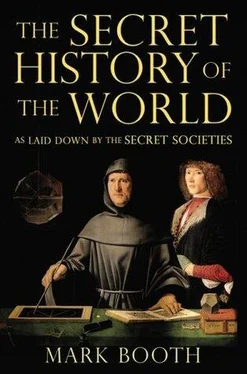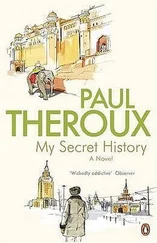Absorbing new ideas as well as spreading them, the Arabs took in Zoroastrianism, Buddhism, Hinduism and Chinese science, including the manufacture of paper. They made great advances in astronomy, medicine, physics and mathematics, replacing the clumsy Roman numerals with the system we use today.
BY ITS OWN ACCOUNT SUFISM HAD ANCIENT, even primordial roots. Some traditions date its origins to the Saramong Brotherhood — or Brotherhood of the Bee — founded in the Caucasus in Central Asia during the first great post-Atlantean migration. Later, Sufism was undoubtedly influenced by Gnosticism and Neoplatonism.
If there was a tendency in Islam in its triumphant period to become dogmatic and paternalistic, Sufism represented a contrary impulse, a fascination with the sometimes perverse and paradoxical twisting this way and that of the spirit. Esoteric Islam advocated immersing oneself in the gentler, more feminine and feeling side of the spiritual life which would find expression in the great outpouring of Sufi poetry.
The question of what constitutes ‘oneself ’ is also a big issue in Sufism. What we generally imagine to be our own self, it teaches, is really an entity that operates independently of us, made up for the most part of fears, false attachments, dislikes, prejudices, envy, pride, habits, preoccupations and compulsions. A lot of Sufi practice involves breaking down this false self, this false will.
‘God is nearer to a man than his jugular vein’ according to the verse from the Koran (50:16), yet for the most part, distracted by our false selves, we are not awake to this.
The great Sufi writer Ibn Arabi said that a Sufi master is someone who unveils one to oneself.
Practices under instruction from a Sufi master might involve breathing exercises and music used to attain an altered state. Sufism taught the sometimes painful process of ‘waking up’, of becoming aware of ourselves and of the cosmic, mystical current that runs through us and becoming more fully alive.
Because they opened themselves totally to this mystic current, Sufis could be wild, unpredictable and disconcerting. We will see later that Sufism has had a vast, though largely unacknowledged, influence on Western culture.
Mohammed’s brother-in-law, Ali, was to him as John to Jesus Christ, receiving and transmitting the secret teachings. Sufis obeyed Islamic law but believed it to be the outer shell of esoteric teaching.
Ali and Mohammed’s daughter, Fatima, established what became known as the Fatimid Empire, ruling a large part of North Africa and Cairo, where they established a school for esoteric philosophy called the House of Wisdom. There were seven initiatory grades taught within. Candidates would be initiated into timeless wisdom and gain secret powers. Sir John Woodruffe, the nineteenth-century translator of the key Tantric texts, also uncovered a Sufi tradition with a parallel understanding of occult physiology. In this Sufi tradition centres of power had beautiful and intriguing names such as Cedar Heart and Lily Heart.
One of the initiates to emerge from the House of Wisdom was Hassan-I Sabbah, the famous Old Man of the Mountains.
He founded a small sect which in 1090 captured the castle of Alamut in the mountains south of the Caspian Sea in modern-day Iran. From his mountain fastness he sent his secret agents all over the world to do his bidding, exerting a puppet master’s control on distant rulers. His Hashishim — Assassins — infiltrated courts and armies. Anyone who even thought of disobeying Hassan was found dead the next morning.
The Western view of Hassan is no doubt distorted by a passage in Marco Polo’s account of his travels. He claimed that the Old Man of the Mountains gave his young followers drugs which put them to sleep for three days. When they woke up they found themselves in a beautiful garden they were told was paradise. They were surrounded by beautiful girls who played them music and gave them anything they wanted. After three days the young men were sent back to sleep. When they awoke, they were brought again before Hassan, convinced that the Old Man had the power to send them back to Paradise on a whim. So when Hassan wanted someone killed, his assassins would do it willingly, knowing that Paradise would be their certain reward.
In reality Hassan banned all intoxicants, even executing one of his own sons for being drunk. He banned music, too. Among his own people he was renowned as a holy man and alchemist, an adept who was able to control events all over the world by supernatural means. This was despite the fact that once he arrived and set up his court there, he only ever left his room at Alamut twice.
In the twentieth century the archetype of the man who appears mad, but really controls the whole world from his cell appeared as Dr Mabuse, in the deeply esoteric films of Fritz Lang.
HAROUN AL RASCHID WAS ANOTHER OF the extraordinary, compelling characters of this era. He became Caliph in his early twenties and quickly made Baghdad the most splendid city in the world, building a palace of unparalleled splendour served by hundreds of courtiers and slaves and a harem. It was a place of glittering materiality, where a man might experience every pleasure the world has to offer, grow bored with them all and long for novelty.
The turbaned oriental potentate of all our imaginations and Caliph of the Tales of the Arabian Nights , he drew to his court all the great writers, artists, thinkers and scientists of his day. It was rumoured that, as related in the Arabian Nights , he would sometimes slip out of a secret door in the palace in disguise in order to eavesdrop on his people and find out what they really thought.
In one of the most famous tales a fisherman on the Red Sea catches a large iron pot in his nets. When he has hauled it on board he sees that the metal cover is engraved with the interlocked triangles of Solomon’s Seal. Naturally curious, the fisherman opens the pot and at once a black vapour rises out of it and spreads itself all over the sky, so that all he can see is darkness. Then the vapour condenses again into the monstrous form of a Jinn, who tells the fisherman he was imprisoned in the pot by Solomon. He says that after two hundred years he swore he would make rich anyone who set him free. After five hundred years he swore he would reward his liberator with power. But after a thousand years of captivity he swore he would kill whoever set him free. So the Jinn tells the fisherman to prepare to die. But the fisherman says he can’t believe the Jinn was really inside the pot, and so the spirit, to prove it, turns himself back into vapour and sinks with a slow, spiralling motion back inside — at which point, of course, the fisherman claps the lid back on.
This might seem just a silly story for children, but for occultists it is packed with esoteric lore. But the word ‘Jinn’ means ‘to hide’, and a detailed theory and practice of dealing with these entities, said to live in ruined houses, in wells and under bridges, was actively cultivated among Arab peoples. Moreover, the imprisoning of spirits and demons in amulets, rings and stones using magical sigils such as the Seal of Solomon was well known. By the Middle Ages such lore, largely Arabic in origin and concerned particularly with the empowering of talismans by astrological means, would be collected in many famous grimoires. The greatest of these, called the Picatrix , would fascinate many of the more influential personalities in this history, including Trithemius, Ficino and Elias Ashmole.
RUMI GREW UP TO BECOME the great poet at court. He was a disconcerting presence even as a small child. At the age of six he began the habit of fasting, and began, too, to see visions. There is a story that one day he was playing with a group of children who were chasing a cat from rooftop to rooftop. Rumi protested that humans should be more ambitious than animals — and then vanished. When the others cried out in fright, he suddenly reappeared behind them. He had a strange look in his eyes, and said spirits in green cloaks had carried him away to other worlds. The green cloaks may have been shadows of El Khidir, the Green One, a powerful being able to materialize and dematerialize at will. The Green One is said by the Sufis to come to the aid of those on a special mission.
Читать дальше












